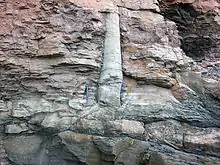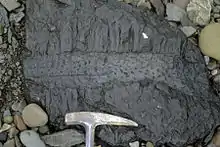Stigmaria
Stigmaria is a form taxon for common fossils found in Carboniferous rocks.[1] They represent the underground rooting structures of coal forest lycopsid trees such as Sigillaria and Lepidodendron. These swamp forest trees grew to 50 meters and were anchored by an extensive network of branching underground structures with "rootlets" attached to them. Analysis of the morphology and anatomy of these stigmarian systems suggests they were shoot-like and so they are called rhizomes or rhizophores. The stigmarian rhizomes are typically covered with a spiral pattern of circular scars where "rootlets" were attached. Since the stigmarian systems are shoot-like, these "rootlets" may be modified leaves, adapted to serve the function of roots. However, some paleontologists argue that the "rootlets" were true roots, with a complex branching structure and root hairs, comparable to the roots of the closest living relative of Lepidodendron, the quillworts (genus Isoetes).[2]
| Stigmaria | |
|---|---|
 | |
| Stigmaria, a fossil lycopsid rhizome. | |
| Scientific classification | |
| Kingdom: | Plantae |
| Clade: | Tracheophytes |
| Clade: | Lycophytes |
| Class: | Lycopodiopsida |
| Order: | †Lepidodendrales |
| Genus: | †Stigmaria Broningart |


References
- Rothwell, GW; Erwin, DM (1985). "The rhizophore apex of Paurodendron: implications for homologies among the rooting organs of Lycopsida". American Journal of Botany. 72: 86–98. doi:10.2307/2443571. JSTOR 2443571.
- Hetherington, AJ; Berry, CM; Dolan, Liam (June 14, 2016). "Networks of highly branched stigmarian rootlets developed on the first giant trees" (PDF). PNAS. 113 (24): 6695–6700. doi:10.1073/pnas.1514427113. PMC 4914198. PMID 27226309. Retrieved 15 February 2017.
| Wikimedia Commons has media related to Stigmaria. |